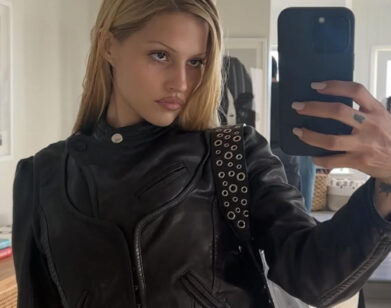Caitlin Price
PHOTOS: JOHANNA NYHOLM. STYLING: NIC JOTTKANDT. HAIR: SARAH JO PALMER USING KIEHL’S. MAKEUP: ROBERTA KEARSEY USING NARS COSMETICS. MODEL: MARIE FOFANA/IMG. CASTING: DAVID CHEN.
Whatever your conception of “day-to-evening” dressing, Caitlin Price is here to turn it on its head. The young London designer studied under the late Louise Wilson at Central Saint Martins’s vaunted MFA program and debuted her eponymous line in 2015 with Fashion East. Since then, she has gained a following for translating streetwear staples like the low-slung track pant or cropped zip-up in slinky, luxurious fabrications and cotton candy hues suited as much for a quick nip out to the store to a raucous girls night out.
Though Price’s designs have landed on the shelves of Selfridges’s and Harvey Nichols, she is the first one is quash any categorizations of her work as part of the current crop of elevated athleisure peddled by other designers. Drawing inspiration from high eveningwear and couture, Price integrates elements such as dramatically draped ruffled panels, sharp cutouts, or intricate seaming to create finely crafted hybrid garments that toe the line between provocative takes on a debutante gown and futuristic clubwear.
For her Spring 2017 collection, Price looked to opposing forces—the sensorial assault of 1960s op-art and the psychedelic set of Jacques Tati’s 1958 film Mon oncle, and the OTT styles of young British women vacationing in Ibiza—for a ten-look collection of tiny jacket and pant matching sets, miniskirts, frocks, and shorts, many of them constructed out of undulating swirls of lime green, lavender, tangerine, and pink. A vintage looking logo sweatshirt emblazoned with the words “Beach Club” was also in the mix.
Interview recently spoke to the designer while she was at home in London.
HOMETOWN: South London, U.K.
BEGINNINGS: It was just a really natural progression. It was never something that I had to make my mind up about because my mum was a dressmaker and she used to make wedding dresses. When I was little, I was always around clothes. I spent all of my weekends dressing up with my best friend. Both our parents made clothes, so we had a big dressing up box of clothes. We were both from really creative families, so it was just really natural. The thing I was most interested in, really, was between fine art and fashion. I was sewing at school when we were doing our GCSEs, but in terms of styling and putting things together, that was from a very young age. Like I said, it was me and my best friend, Amy, and every weekend we were so imaginative. It was around the time of the Spice Girls and the Spice Girls had those albums with backstage sort of stuff [in them] and we had our own version of that. We have a whole album of all these pictures of us, pretending we’re in a band backstage putting funny outfits on. [laughs]
BONA FIDES: I did an art foundation after I left school and then I went to Brighton University for three years to do BA Fashion Design. From there, really, I was pretty serious. I never had the intention of doing my own line, but I knew that I could. I’ve always been a hard worker, so I just got on with it. My tutor from Brighton University encouraged me to apply for the Masters at Saint Martins, so that’s when it got a bit more serious. I knew I had to make it happen if I wanted to.
AESTHETIC: There are a lot of different elements to what I do. Essentially, people recognize it as “sports-luxe.” I don’t like to use that word too much. I try not to focus on that, but I know that excites people and it makes sense coming from where I come from, because those are shapes that I wear, like tracksuits and stuff like that. [My line] has the underpinnings of casual silhouettes that you recognize, but then it’s also fused with the eveningwear element. The bulk of my research tends to be dress history or eveningwear more than sportswear. There’s a lot of people into that aesthetic, but in terms of the garments and styles, I like to describe them as hybrid pieces. There’s the pair of perfect bottoms; there’s a tailored tracksuit bottom and it’s made in a beautiful stretch crepe, and then it has half of an evening gown skirt built into it.
There’s a humor in it as well. There’s the danger of fashion being too serious, so I think there’s a lot of my personality in the work. You can see my interpretation of fashion. I love high fashion. I love couture. I research so much into historical fashion, although those things might not be instantly recognizable to people who look at the work. To me, that’s where the most exciting part of it lies. I use the sports pieces like the tracksuit, and those familiar shapes, and then I try to elevate those things by fabrication or textile or finish or fabric.
There will be some things that we will do in-house, but there are other things that we would do at the factory. Everything is done in the U.K., but some pieces are hand-finished. It’s a mix, but most of it is a technique that I would develop myself from working on the stand or just sampling. Then I’ll teach the interns how to do it and then we’ll do it between fittings. It’s very hands-on.
SPRING/SUMMER 2017: I was looking at a mixture of kind of quite contemporary references, girls going on a girls’s holiday to Ibiza or Marbella, which is a thing to do in this country, and the way that those girls are very done up. They’re essentially going to be lounging around the pool, but they’re in full makeup and hair. That was a quite playful reference in the styling, but the actual clothes were inspired by a lot of 1960s references. There was a film by Jacques Tati [Mon Oncle, 1958] and it’s very vivid. All of the colors are so bright. It’s all designed about this really artificial set and the colors in that film just stuck in my mind for some reason, acidic pops of color against a black background, like a black night sky. That’s where the color palette came from. And then 1960s pop art, those optic swirl shapes came from psychedelic prints and I translated them into multi-fabric panels. All of the swirls are inspired by prints, like Pucci, but then we translated that into fabric. It was a lot of color for me last season, less about drape. Every season has a different focus. I don’t like to repeat things too much, so last season was definitely about the color palette and the color fabrication. The cutout thing is always a reference to the club-wear element that undertones things as well. It’s more of a styling thing, really, than anything, the cutout.
STYLING: I’ve styled everything from the beginning. I’ve never worked with a stylist. That won’t be the case forever, but for me, while the collections are still small [I style]. Collections are personal as well, and I have an idea from the beginning about how I want the styling to be. I know what the music is, and I know where the girl is.
WHAT’S NEXT: Each collection follows on from the other, whereas this [Fall 2017] collection I literally wanted to focus on the clothes and nothing else, really, so it is just an exploration of cut and color and paneling and drape. There’s a lot of draping in it and there’s a lot of late ’50s, early ’60s references and it’s very much to me about power dressing for women, a new power dressing. It’s not followed on from the previous stories of girls going on a night out. For me, it’s a separate body of work, but it’s something that I wanted to explore. I’m growing up and ultimately trying to think about where I’m trying to take the brand long-term, and I was trying to do that this season.
GOALS: I can’t ignore what things sell and what buyers want. I’ve always done a slightly different thing each season, and you instantly know once you get the buyer’s feedback, “Ah, shit. I shouldn’t have done that.” Each season you put out something, you try out a new thing and it’s like, “Okay, that didn’t work,” or “Oh, that was brilliant.” It’s funny, though, what things depend on. If you get a celebrity to wear it and then that’s suddenly like… Bella Hadid wore this pink outfit of mine the other week, and we then sold out of all the pink skirts that she was wearing on the web-store. It’s funny just how things like that happen.
I have to always consider those things, otherwise it won’t last, so you have to take everything into account. It’s always a balancing act. But to me, the thing that is most enjoyable and the way that I see the brand going in the future is down the eveningwear route. The sportswear aspect will always be the underpinning because that’s just true to me. I think buying an evening gown or a jumpsuit, a big dress, those things are what women really want to spend their money on.
TO LEARN MORE ABOUT CAITLIN PRICE, VISIT HER WEBSITE.







